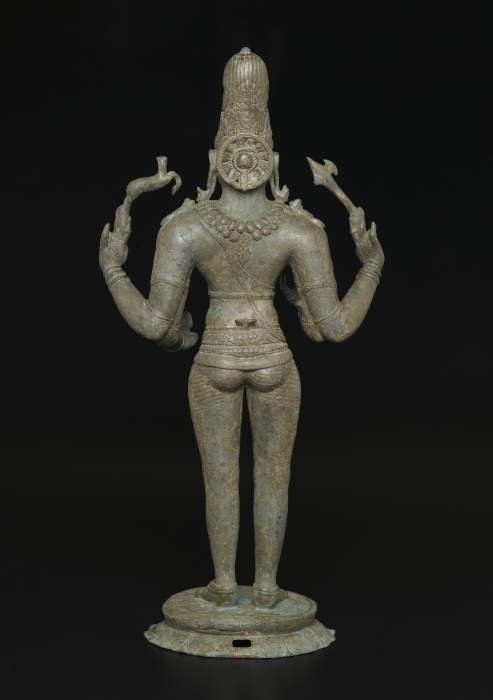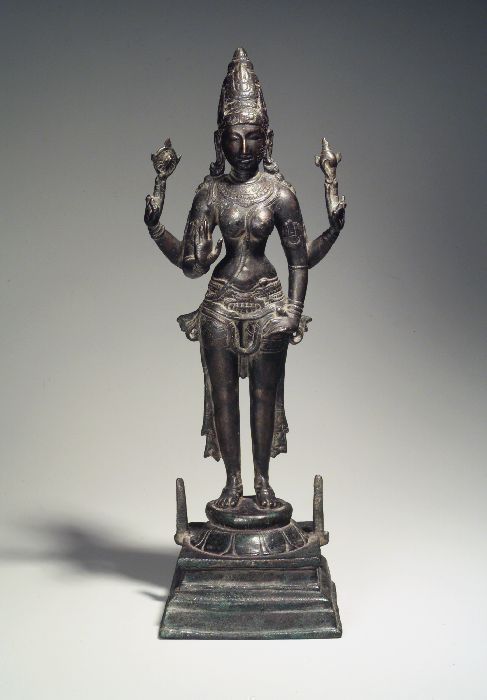Purchasing a Major Work of Art for the Collection – part IV
I have been discussing the process of acquiring a new masterpiece for the collection, and in my first installment, I introduced the object, a bronze image of Shiva from southern India. This sculpture was cast by the master artisans who created numerous temple icons in bronze under the patronage of the Chola dynasty, which ruled southern India from the 9th through the 13th century. In my previous entry, I noted that a Chola-period bronze was one of the types of objects we were targeting for the purchase we hoped to make in honor of my predecessor.
Chola bronzes have long been considered the apex of Indian sculptural achievement. These images feature outrageously sensuous figures, with soft, curving bodies and long, languorous limbs, usually only minimally clothed but with plenty of jewelry that drapes to accentuate the contours of the torso. The males have impossibly broad shoulders; the females have enormous round breasts. They don’t look like real people, but they’re not supposed to: they’re gods, and as such, they are supposed to be more beautiful, more relaxed, and more powerful than any human could ever be. To see what I’m talking about, please have a look at our image from behind.

Shiva as Chandrashekhara, view of reverse. Southern India, Chola period, c. 970 A.D. Bronze. Height 25 inches. Brooklyn Museum, Gift of the Asian Art Council and other donors in honor of Amy G. Poster, 2007. 2.
Nice, huh?
Chola bronzes have been the darlings of collectors since they were first “discovered” by Western art historians in the late 19th century. As a result, most of the really great examples have already made their way to museums in India, Europe, and the U.S. (there are still quite a few being worshipped in temples in southern India as well). Any museum wishing to boast a good collection of Indian art should have at least one Chola-period bronze. Some museums have rather large holdings of these beautiful figures; the Norton Simon Museum in Pasadena has dedicated an entire room to their exquisite collection of South Indian bronzes – leaving curators from other museums feeling green with envy. Several museums with otherwise fine collections of Indian art, like Brooklyn, have a few minor Chola pieces but would really like to find one show-stopper. Hence, the appearance of a Chola bronze on our “wish list.”
Actually, we really can’t say that Brooklyn only had minor examples of Chola bronzes. The truth is that we were given an important bronze in 1992 by a donor with a very good eye. The image is of the Hindu goddess Durga, and I am illustrating her below.

Durga. Southern India, Chola period, c. 970 A.D. Bronze. 57.2 x 20 cm. Brooklyn Museum. Gift of Georgia and Michael de Havenon in memory of William H. Wolff, 1992.142.
She isn’t as curvy or as sensuous as most female figures produced by the Chola-period craftsmen (most of the goddesses stand with one hip thrust dramatically out to the side and the rest of the body swaying back to compensate). Nor is she as large as many images of the period. As a result she is a bit of a sleeper. However, she was included in both of the big, splashy Chola bronze exhibitions that took place recently in the U.S. and London because it turns out that images of Durga are extremely rare, and she is quite early in date. So Brooklyn can actually boast one very important Chola bronze.
So why were we looking for another one? Well, a museum collection isn’t just a trophy cabinet, it’s a teaching tool. When using our collection to teach people about the history of Indian art, it is nice to be able to point to specific objects and talk about how they reflect major themes and trends in taste or aesthetics, religious belief and practice, or patronage of the arts. And the truth is that our Durga does not do a great job of reflecting the major themes and trends of her period because she is simply too unusual. If you really want to illustrate the important art-making period of the Chola kings, you need an image of the Hindu god Shiva, who was far and away the most prominent deity of the time, or possibly an image of his wife, Parvati. So in looking for a Chola bronze, we were really looking for an object that could stand in for the tradition as a whole. This was not going to be an easy thing to find.
Next time, the curator and her supporters begin their hunt…

Joan Cummins is the Lisa and Bernard Selz Curator of Asian Art at the Brooklyn Museum. Joan received her Ph.D. in 2001 from Columbia University. Prior to coming to Brooklyn, Joan served as Assistant Curator of Indian, Southeast Asian, and Himalayan Art at the Museum of Fine Arts, Boston. Her most recent book is an introduction to Indian painting, published in 2006 by the MFA, Boston. Joan was a Research Associate in Brooklyn's Department of Asian Art from 1991-1993.
